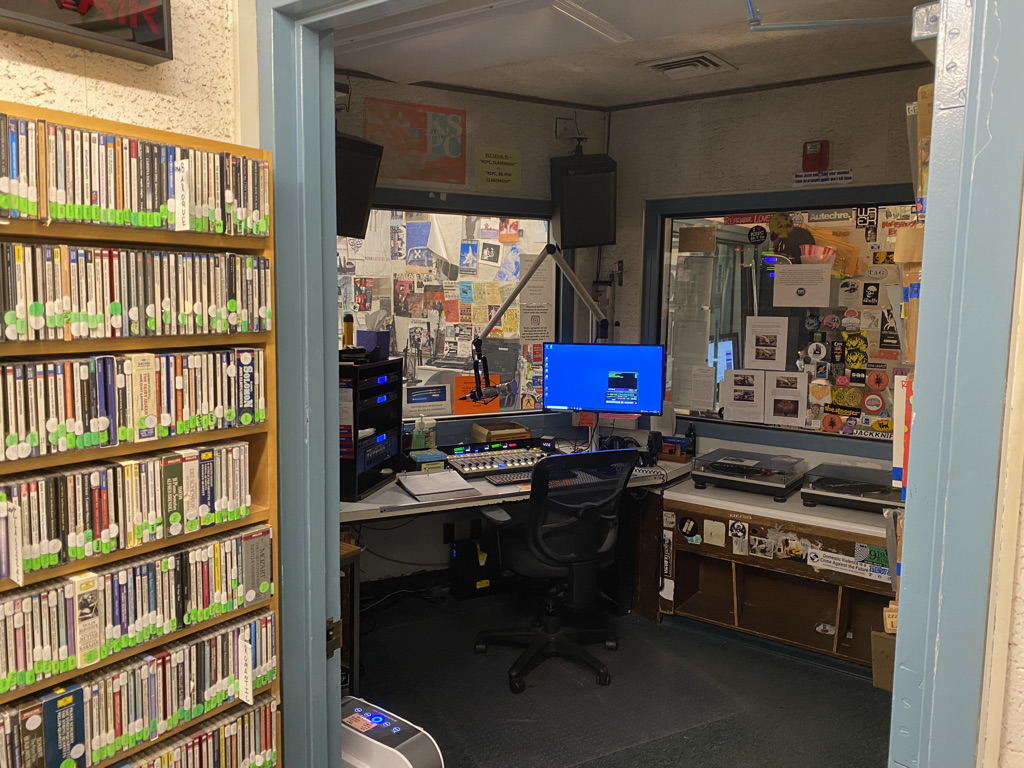|
Variety (radio)
Variety is a radio format that plays music across numerous genres. Free-form radio, Free-form variety is associated with a wide range of programming including talk, sports, and music from a wide spectrum. This format is usually found on smaller, Non-commercial activity, non-commercial public broadcasting stations such as Campus radio, college radio, community radio or high school radio stations. If a variety-formatted station has a program director, that person exerts little if any influence on the music or other programming choices beyond the normal regulatory control required by that country's licensing regulations. Variety is also associated with full service (radio format), full-service radio. This format is primarily found in the rural United States, on commercial AM stations, and on a few FM public radio stations (usually those that play jazz). These stations tend to favor older listeners and play a mix of music that focuses more on older mainstream music, although much bro ... [...More Info...] [...Related Items...] OR: [Wikipedia] [Google] [Baidu] |
Radio Format
A radio format or programming format (not to be confused with broadcast programming) describes the overall content broadcast on a radio station. The radio format emerged mainly in the United States in the 1950s, at a time when Radio broadcasting, radio was compelled to develop new and exclusive ways to programming by competition with Television broadcasting, television. The formula has since spread as a reference for commercial radio programming worldwide. A radio format aims to reach a more or less specific audience according to a certain type of programming, which can be thematic or general, more informative or more musical, among other possibilities. Radio formats are often used as a marketing tool and are subject to frequent changes, including temporary changes called "Stunting (broadcasting), stunting." Except for talk radio or sports radio formats, most programming formats are based on commercial music. However the term also includes the news, bulletins, DJ talk, jingles, c ... [...More Info...] [...Related Items...] OR: [Wikipedia] [Google] [Baidu] |
Binghamton, New York
Binghamton ( ) is a city in the U.S. state of New York, and serves as the county seat of Broome County. Surrounded by rolling hills, it lies in the state's Southern Tier region near the Pennsylvania border, in a bowl-shaped valley at the confluence of the Susquehanna and Chenango Rivers. Binghamton is the principal city and cultural center of the Binghamton metropolitan area (also known as Greater Binghamton, or historically the Triple Cities, including Endicott and Johnson City), home to a quarter million people. The city's population, according to the 2020 United States census, is 47,969. From the days of the railroad, Binghamton was a transportation crossroads and a manufacturing center, and has been known at different times for the production of cigars, shoes, and computers. IBM was founded nearby, and the flight simulator was invented in the city, leading to a notable concentration of electronics- and defense-oriented firms. This sustained economic prosperity ear ... [...More Info...] [...Related Items...] OR: [Wikipedia] [Google] [Baidu] |
WBNW-FM
WBNW-FM (105.7 MHz) -- branded "Now 105-7" -- is a commercial radio station in Binghamton, New York. The station airs a Top 40-CHR radio format and is owned by iHeartMedia, Inc. On weekdays, it carries several nationally syndicated programs including ''Elvis Duran and the Morning Show'' in AM drive time and ''On Air with Ryan Seacrest'' in middays. WBNW-FM is the primary entry point of the Emergency Alert System in Central New York. The studios and offices are on North Jensen Road in Vestal. WBNW-FM is a Class B FM station. It has an effective radiated power (ERP) of 35,000 watts. The transmitter and tower are on Robinson Hill Road in Endwell. History The station signed on the air in . It began on 105.5 MHz and was only powered at 3,000 watts, a fraction of its current output. The original call sign was WMRV. Those call letters were chosen for TV entertainer and game show creator Merv Griffin, who owned it and its sister station, WENE 1430 AM. When Griffin and hi ... [...More Info...] [...Related Items...] OR: [Wikipedia] [Google] [Baidu] |
Adult Contemporary Music
Adult contemporary music (AC) is a form of radio-played popular music, ranging from 1960s vocal and 1970s soft rock music to predominantly ballad-heavy music of the 1980s to the present day, with varying degrees of easy listening, pop, soul, R&B, quiet storm and rock influence. Adult contemporary is generally a continuation of the easy listening and soft rock style that became popular in the 1960s and 1970s with some adjustments that reflect the evolution of pop/rock music. Adult contemporary tends to have lush, soothing and highly polished qualities where emphasis on melody and harmonies is accentuated. It is usually melodic enough to get a listener's attention, abstains from profanity or complex lyricism, and is most commonly used as background music in heavily-frequented family areas such as supermarkets, shopping malls, convention centers, or restaurants. Like most of pop music, its songs tend to be written in a basic format employing a verse–chorus structu ... [...More Info...] [...Related Items...] OR: [Wikipedia] [Google] [Baidu] |
Adult Standards
Adult standards (also sometimes known as the nostalgia or Big Band format) is a North American radio format heard primarily on AM or class A FM stations. Adult standards started in the 1950s and is aimed at "mature" adults, meaning mainly those people over 50 years of age, but it is mostly targeted for senior citizens. It is primarily on AM because market research reveals that only persons in that age group listen to music on AM in sizable numbers. Adult standards first became a popular format in the late 1970s and early 1980s as a way to reach mature adults who came of age before the rock era but were perhaps too mature for adult contemporary radio or too young for beautiful music or MOR stations. A typical adult standards playlist includes traditional pop music by artists such as Frank Sinatra and Tony Bennett, some easy listening numbers from Roger Whittaker and others, and softer tunes from the oldies and adult contemporary music formats. As originally conceived, the f ... [...More Info...] [...Related Items...] OR: [Wikipedia] [Google] [Baidu] |
Oldies
Oldies is a term for musical genres such as pop music, rock and roll, doo-wop, surf music from the second half of the 20th century, specifically from around the mid-1950s to the 1980s, as well as for a radio format playing this music. Since 2000, 1970s music has been increasingly included in this genre. " Classic hits" have been seen as a successor to the oldies format on the radio, with music from the 1980s serving as the core example. Description This category includes styles as diverse as doo-wop, early rock and roll, novelty songs, bubblegum music, folk rock, psychedelic rock, baroque pop, surf music, soul music, rhythm and blues, classic rock, some blues and some country music. Golden Oldies usually refers to music exclusively from the 1950s and 1960s. Oldies radio typically features artists such as Elvis Presley, Chuck Berry, The Beatles, Jerry Lee Lewis, The Beach Boys, Frankie Avalon, The Four Seasons, Paul Anka, Neil Sedaka, Little Richard and Sam Cooke ... [...More Info...] [...Related Items...] OR: [Wikipedia] [Google] [Baidu] |
Free-form Radio
Free-form, or free-form radio, is a radio station programming format in which the disc jockey is given wide or total control over what music to play, regardless of music genre or commercial interests. Freeform radio stands in contrast to most commercial radio stations, in which DJs have little or no influence over programming structure or playlists. In the United States, freeform DJs are still bound by Federal Communications Commission regulations. History in the United States Many shows claim to be the first free-form radio program, but the earliest on record is "Nightsounds" on KPFA-FM in Berkeley, California, D.J.'d by John Leonard. Probably the best-remembered in the Midwest is Beaker Street, which ran for almost 10 years on KAAY "The Mighty 1090" in Little Rock, Arkansas, beginning in 1966, making it also probably the best-known such show on an AM station; its signal reached from Canada to Mexico and Cuba, blanketing the Midwest and Midsouth of the U.S. WFMU is curren ... [...More Info...] [...Related Items...] OR: [Wikipedia] [Google] [Baidu] |
Full Service (radio Format)
Full-service radio is a type of radio format characterized by a mix of music programming and a large amount of locally-produced and hyperlocal programming, such as news and discussion focusing on local issues, news, sports coverage, interviews, call-in segments, and sometimes religious content. The aim of full service radio is to provide a one-stop shop for listening needs and serve a wider demographic. Music played may be a variety or catered to a certain demographic, usually by local DJs. Full service radio saw a decline after television became widespread in the 1950s. See also *Tradio Tradio is a type of phone-in radio program formatted to provide a venue for listeners to freely advertise items they have to sell or trade. The concept is analogous to classified ads in local newspapers and most prevalent in the south and midw ... References {{Radio-stub Radio formats ... [...More Info...] [...Related Items...] OR: [Wikipedia] [Google] [Baidu] |

